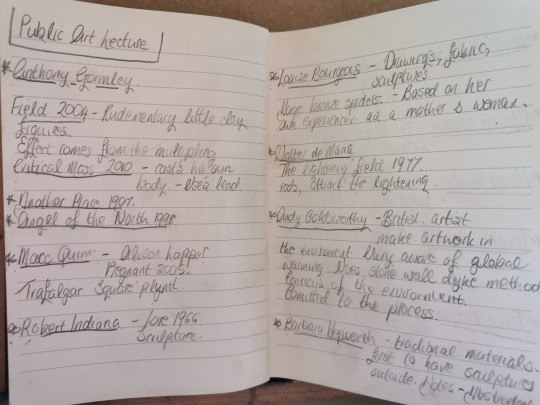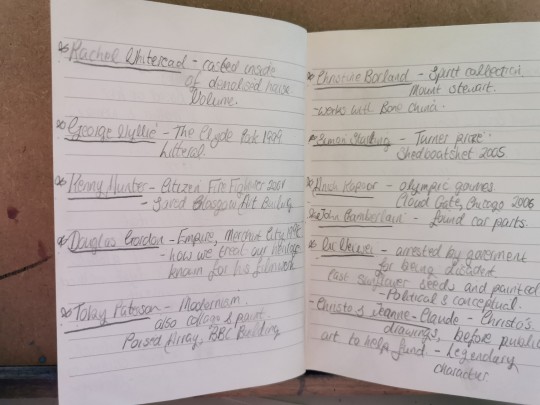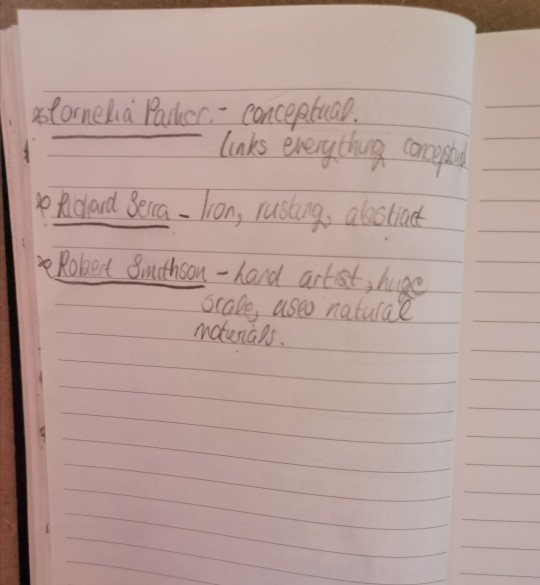Text
Folio 3 Artist Lecture
Folio 3 Artists
Sculpture
Carl Andre – American Minimalist sculpture, Equivalent 8 known as the bricks. 125 fire bricks arranged in two layers. Extremely controversial piece of work.
Anthony Caro - British abstract sculptor. Known for industrial steel works. Exploring the boundaries between art and architecture. Look like Miro paintings bought to life.
Bruce Nauman – conceptual artist, American. Dance or Exercises on the Perimeter of a Square. Clown Torture. Anxiety, boredom, entrapment and failure. One Hundred Live and Die, one of the first people to work with neon tubing.
Nam June Paik – Korean artist. Video installation. Continental U.S Alaska. Physical and cultural contours of America.
Jenny Holzer – American conceptual artist. Uses digital technology and led screens for her installations and public art work.
Edward Weston – One of the seven pillars of fine art photography. Organic forms and refreshing take on the nude.
Sophie Calle – French conceptual artist and photographer. Installation view of the Sleepers – invited 24 people to occupy her bed for eight days. The Address book. Take Care of Yourself – asked dozens of women to interpret a break up email. What do you see? Deals with the size paintings stolen from Boston’s Isabella Stewart. Took portraitures of staff in front of empty frames.
Hiroshi Sugimoto – taken with a long exposure – captures blinding which screen. Illuminates the space.
Jim Dine’s Tool Series – Screen prints inspired by engineering text books.
Gary Hume – screen prints derived from paintings. American Tan.
Jake & Dinos Chapmans Goya series – Worked over original etching series of Goya’s the Disaster of War – very old traditional work and controversial.
David Haines – British artist – massive drawings hyper realistic dealing with mass media and adolescents. Brutally at offs with the meditative nature of the artist method.
Kate Downie – Born in North Carolina, studied at Greys regarded as Scottish Artist. Live Drawing series – drawing directly onto wall.
Richard Wright – striking gold – modern fresco painter. ECA and post grad at GSA. Won the turner prize.
Doris Salcedo – Columbia – visual artist and sculpture – mass violence, trauma, racism and colonialism. 280 chairs at the Palace of Justice in Bogota, to pay homage to those killed her in a failed guerilla coup seventeen years earlier.
Cecily Brown – London born based in New York – Bacchanal 2001 Overrent sexual imagery in abstract expressionist gestural style. Subvert the machismo of the male artist before her into a kind of upflashing examination of human nature. Teenage Wildlife.
Walton Ford – American painter and printmaker who makes painting in the detailed naturalist style of 18th Century omnithologist Aububon.
Phillip Gurrey – WW2 photography Pery Hennel’s images.
Maurizio Anseri – born in Italy works in London. Penny 2009. Sews directly onto vintage photographs. Surrealist in nature.
David Mach – Large scale collages, Tower of Babel.
Fred Tomaselli – American – known for highly detailed work 3D work covered in 3D resin. Car Bomb – Hang Over.
Teleki Schartz – combines mixed media with focus on embroidery focuses on her Jewish heritage.
Ibrahim Mahama – known for jute sacks. The Labor of Many. Covered neo classical tollgates in Milan.
0 notes
Text
Phylida Barlow
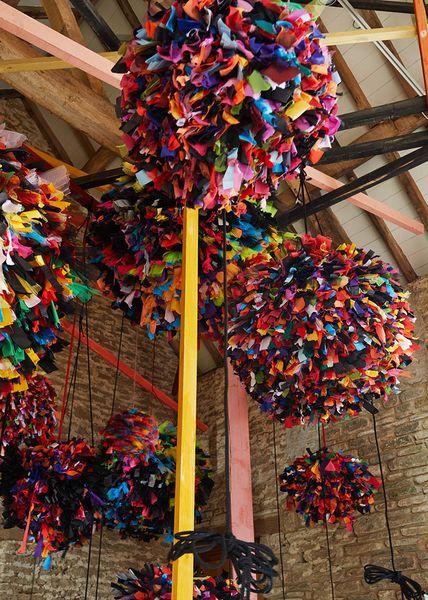



Barlow was born in Newcastle, England, in 1944 but was brought up in London which at the time was recovering from the impacts of the second world war. Barlow studied at Chelsea College of Art (1960-63) under the guidance of George Fullard who inspired her broadened perception of sculpture:
“Fullard, among others, was able to impart that the act of making was in itself an adventure. A sculpture that falls over or breaks is just as exciting as one that reveals itself perfectly formed. All the acts of making in the world are there to be plundered and contain within themselves the potential to be transferred to the studio and adapted.”
Barlow is married to fellow artist and writer Fabian Benedict, who she met whilst studying at Chelsea College of Art. Barlow then went on to further study sculpture at Slade School of Fine Art (1963-66). On graduating Barlow began teaching at various institutes starting with the University of the West of England, Bristol and retiring from Slade School of Art in 2009 deciding to focus on her own art work. Barlow’s belief was art schools placed too much importance on a specific model of how to be an artist.
Barlow initially started creating sculpts using traditional techniques with a fascination for the everyday, using accessible materials like polystyrene, scrim, cement and clay. Her focus was creating abstracted sculptures that held a sense of elevated meaning, creating an environment of reflection and exploration for the viewers. Barlow’s work moved on to include industrial materials such as plywood, plaster, cement, fabric and paint but remained consistent in her approach of using inexpensive and accessible materials. Barlow’s work grew in scale to colossal projects which she is now renowned for, playing with scale, mass, and height to create a tension in her forms from the sheer scale. Barlow uses child like colours which an illude to the reference of toys, in compete juxtaposition with the scale and industrial materials used in her work. The materials and the process Barlow uses is visible in her work, purposely choosing to expose the detail. Barlow’s projects can give the impression of being densely heavy but at the same time light and air creating a presence of an environment rather than an individual sculpture.
Barlow draws on memories of familiar objects from her surroundings to create her sculpts and her work is characterised through her physical experience of transforming the materials through layering, accumulation, and juxtaposition. Barlow’s projects portray delicate balance, obtrusion and challenge the experience of the viewer:
“Maybe I don't think enough about beauty in my work because I'm so curious about other qualities, abstract qualities of time, weight, balance, rhythm; collapse and fatigue versus the more upright dynamic notions of maybe posture ... the state that something might be in. Is it growing or shrinking, is it going up or down, is it folding or unfolding?.”
0 notes
Text
Pablo Picasso
Picasso was born into a middle-class background in Malaga, Spain in 1881. His father, Don Jose Ruiz y Blasco, was also a painter, specializing in natural depictions of birds, and was a professor of art at the School of Crafts as well as a curator at a local museum. Picasso received formal traditional training from his father from a young age, with a focus on figure drawing and oil painting. Following the death of his younger sister, Conchita, at seven year old the family moved to Barcelona in 1985 where Picasso was received early admission to the School of Fine Arts at only 13 years old. At 16, Picasso attend Real Academia de Bellas Artes de San Fernando, the country’s leading art school in Madrid. In the early 1900’s Picasso visited Paris, the art epicenter of the time, where he eventually settled in 1904. Picasso’s work spanned over serval artistic movements, however, he is primarily known as a Cubist painter. Picasso lived through World War I, World War II and the Spanish Civil War, however, never enrolled to fight and remained a painter throughout these times. Picasso was politically a communist.
Picassos was primarily a painter and his vast body of work spans many years and is subsequently broken down into different periods of his life. The Blue Period (1901 – 1904) showed somber paintings rendered in only shades of blue and green. The paintings often depicted gaunt women with their children. Some of the key pieces from the this time included; The Frugal Repast (1904), the Blind Man’s Meal (1903) and Celestina (1903). The Rose Period (1904 – 1906) is exemplified by use of lighter tones, primarily oranges and pinks, featuring; circus performers, acrobats, and harlequins. A key piece from this is Portrait of Gerturde Stein (1906). African art and primitivism (1907 – 1909) was where Picasso really started to explore abstraction, most notably with the piece Les Demoiselles d’Avignon (1907). From here Picasso really started to explore Cubism, the style in which he is most prolifically known, starting with Analytic Cubism (1909 – 1912). During this period Picasso analytically studied objects and simplified the studies into shapes. Synthetic Cubism (1912 – 1919) began the exploration of paper fragments and the first use of collage in fine art. Picasso’s work grew to be more minimalist and abstract throughout this period with a focus on breaking away from Renaissance tradition to focus on the use of perspective and illusion. Picasso’s paintings, like the Cubist’s of his time, use colour as a form of expression and explore the subtilties of colour to create from and space. Although Picasso’s Cubist works explores the abstract, he sought to base his paintings on real life subject matter rather than the imagination; however, painting mostly from memory. A key piece from this time is Three Musicians.
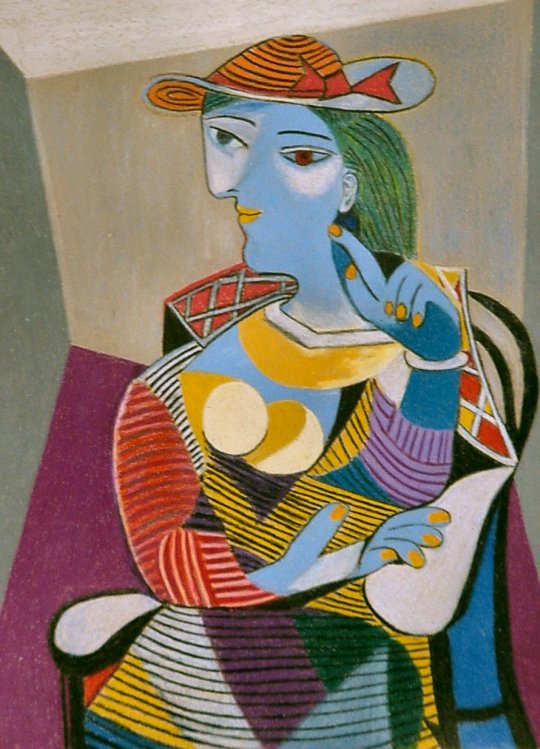
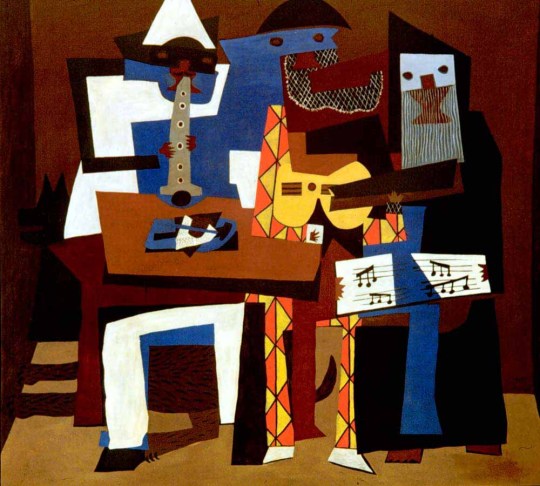
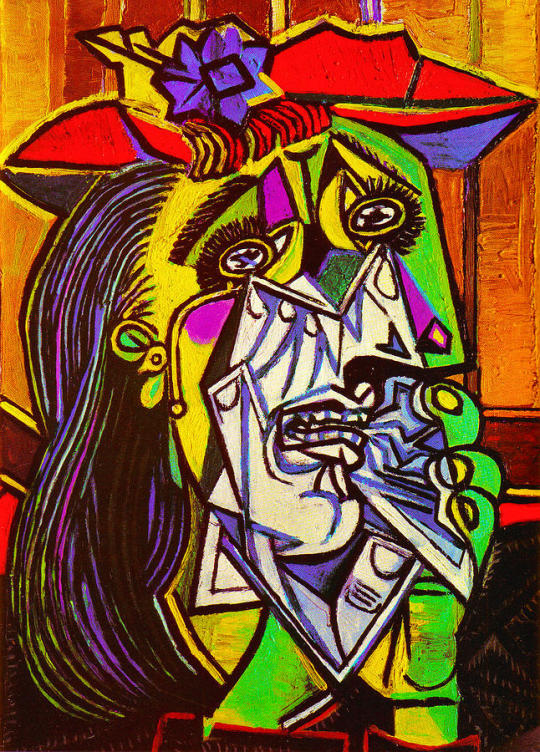
0 notes
Text
Notes Modernism: Fauvism, Cubism, Futurism & Vorticism
Modernism
Blanket term for a multitude of movements
Fauvism, Cubism, Futurism, Dadaism, Surrealism, Constructivism, Abstract Expressionism, Conceptualism, Post Modernism, Minimalism, Sensationalism, New Expressionism
Isms-
Broad cultural, artist defined and retrospectively applied – not until the work is produced until the movement is defined.
Evolving ideas – reinventing what’s gone before. Constant breaking of the mold all the time. Developing a language visual of the times. Representing a rejection of accepted or traditional styles.
Who was the first modern artist? – trying to understand the origins. Difficult to pinpoint the idea. Picasso, Dechamp, Magritte?
Fauvism
The Fauve painters took the idea of the post impressionist’s and too the idea of colour and really shook up the need to paint representational colours. Colours that weren’t physically there but were emotive. Encompassing feeling through colour. Took pointillism style and evolved the style using bright colours, naive quality. One ism takes influence from the previous but making the molds of the other. They called themselves the wild beasts.
Cubism
Cubism rejects the idea that paintings should depict a single viewpoint, form and space broken down into geometric shapes.
Painting from several points of view on the same canvas. Analytical cubism – you can still understand there is shape and form. Synthetic Cubism – simplification of shape, overlapping, birth of collage. Start to go more abstract. Much of the Dada movement, early work of Cubism.
Braque – small bits of objects and references in them that are recognizable. Brings the idea of dreamlike state – surrealism?
Futurism
Rejects cubism, too intellectual and static. Futurism, becomes stylized. Good example of whats going on around, rejecting the past and embracing the future. Machinery, factories, technology – representation of what was going on at the time. Focusing on the city, noise and movement, Interested in creating a shop value.
Vorticism
Smaller movement – idea of the new vortex. Combined cubist fragmentation with the machine of the modern environment. Took cubism and futurism and combined it. European movement, British.
0 notes
Text
Edar Degas
Edar Degas was a French Impressionist artist born in 1834 in Paris and lived until 1917. Degas was born into a moderately wealthy family and was the eldest of five children, his mother dying when he was 13 years old. Upon graduating from school at 18 Degas registered as a copyist at the Lourve Museum, however, there was family expectations that he should pursue a career in law. Subsequently, he enrolled at the Faculty of Law at the University of Paris in 1855, however, showed little interest in his studies and choose to attend Ecole des Beaux-Arts. Following this Degas spent three years with his Aunt in Naples where he made the first studies of his early work, The Bellini Family. In 1870 Degas joined the National Guard due to the outbreak of the Franco-Prussian War.
In 1874 Degas joined a group of young artists who were organising an independent exhibition society, this group soon became known as the Impressionists. Between 1874 and 1886 they organized eight exhibits know as the Impressionism Exhibitions. Degas has little in common with he other landscape artists and found the scandal of the exhibitions distasteful due to his conservative upbringing.
Degas was one of the founders of Impressionism, however, preferred to be referred to as Realist. Degas closely studied classical art and had great admiration for the old masters, specifically Jean-Auguste Dominique Ingres and Eugene Delacriox. Degas was most renowned for his oil paintings and pastel drawings depicting dancers and focused on capturing movement without his work. Indicative of the Impressionist movement, Degas’s work primarily focused on capturing everyday scenes with a particular interest on capture moments, creating images of; dancers, bathing women, racehorses, racing jockeys, portraits and café life. Some of Degas’s most renowned work, when observing café life, were Singer with a Glover and L’Absinthe, most known for their ambiguous nature and hinting or narration. Degas moved painting to the 3D in 1881 when he started to exhibit sculpture, most famously The Little Dancer of Fourteen Years – a realistic, life-sized sculpture with real life hair and a cloth tutu.

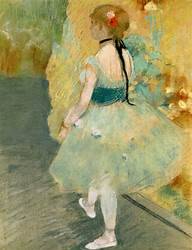

0 notes
Text
Notes Impressionism & Post Impressionism
Impressionism & Post-Impressionism
Moent, Manet, Degas, Sisley, Renoir, Cassatt, Morisot, Bazille
Spontaneous work. 1874. So different for the time.
Aim to capture visual impression of the scene, impression of it, wasn’t about it being real. Colour, changed, mood changed. 1840 – First tubes of paints came around then.
Boudin – taking on board Impressionism, first to paint outside.
Claude Monet – Prolific Impressionist.
Impression interested in everyday scenarios and everyday environments. Prior to this royals, epic battles were focus of subject. Bringing to light an obsession with the everyday. Fascinated with light – repeating the same image but in different light.
250 Water lilly paintings.
Basille – known as a realist paintiner but include in the impressionist show. Depicting everyday scenes, views from windows, people at work. Context, this hadn’t been seen as a subject metter before.
Sisley – colour and light, dialed up in colour.
Unpopular at the time, and weren’t accepted, the avant-guard of their time.
Renoir – leading impressionist painting. Look at the everyday, multiple scenes of movement – upper class in everyday setting. Capturing a moment in time.
Manet – shocking subject matter, causing great controversy. Nude and a person of colour, revoloutionary at the time – hitting a nerve.
Composition and narrative is important – why are you painting this? Setting a scene for questioning. Females very much involved in the impressionist movement – Morisot, Cassatte.
Degas, so interested in movement. Becoming intimate with the subject matter and finding a moment in the image. Painted dancers. Moved into 3D work.
Degas – snapshots of real life.
First film was starting to happen and communication was taking on at the time. What was going on at the time heavily influcences the art world.
The Eifle Tower was being constructed at the time – what that meant as a symbol. Paris scene as thee epicentre of the modern age.
With the death of Queen Victoria came the rise of Post-Impressionism.
Cezanne, Deraine, Matisse, Picasso, Seurat & Van Gogh.
Coined around 1910 – Post-impression forms the foundation of early modernism and gives birth to all the other movements. All about brush stroke, colour and is stylized – moving away from the natural world. Gives a gateway to allow painters to see things as fantasy. Becomes niave in the mark marking deliberately.
Serat – pioneer of Divisionism or Pointillism. Creating subtle illusion, gives a dream like quality. Sense of a flattening out of the image – same value.
Van Gogh – Under-rated until his death, troubled life. Impression and expression of what he is looking at.
The Potato Planters – 1884 – Set the tone of Van Gogh of what and how he was painting. How the everyday working person was important and celebrated.
Most famously known for Sunflowers. Acute mental health and art have a close relationship – Van Gogh was ana outsider wasn’t accepted. Trueism – painting yourself as you are not as you want to be. Made more than 2000 artworks in his time, best works produced in later years of his life. Most expensive painting.
Picasso – Boy with Pipe.
Cezanne – View from where he lived, painted 60 times by Cezanne. The mood and impression of something can change, how the mood changes with the artist. Took on board all the impressionist ideas and pushed it forward.
0 notes
Text
Notes from the Story of Modern Art
Modern Art period – 1860s to the 1970’s
Term associated with the conscious break of art traditions in the spirit of experimentation demonstrated through the use of radical approaches to composition, materials & imagery.
Influencing Factors – pre 1850s
The scientific revolution (16th – 18th Centuries) – began to question the certainties in religion that had been the pillars of communities & cultures.
Age of Enlightenment (18th Century) – the idea that people can think and reason for themselves, rather than following suite to religious teachings. Age of philosophers like Voltaire.
Age of Reflection or Romanticism (19th Century) – Understood as a reaction to the rational & scientific understanding of the world. Placing importance on the individual & emotional experience in the world.
Social Changes of the 19th Century
Urbanization, more people moving to the city. Societal structure change and in the invention of a middle class. Increased travel, more seeing of the world & cultures than ever before.
Scientific factors (19th -20th Centuries)
Photography – changing how we see the world. Why try paint realistically when a photograph can do a better job?
Telecommunication – phone, radio, cinema – changing how we communicate and interact.
Pre Modern Art (1860-80)
Impressionism – Renoir, Manet, Mary Cassatt, Money, Pissaro, Degas
Reflecting the changing qualities of light & movement – open loose brush strokes, using everyday subject matter,
Post-impressionism – Van Gogh, Seurat, Toulouse-Lautrec, Monet, Cezanne, Degas, Gaugin
Reacting against naturalism of impressionism exploring colour, line, form & emotional response. Led to development of expressionism.
The Pioneering Early / Emerging Modernists (1900-1910)
Fauvism – Henri Matisse, Andre Derain
Thrived in Paris 1905. Vividly expressionistic & non-naturalistic use of colour. Matisse regarded as the movements leading figure. Important influence on subsequent artists.
Expressionism
Edvard Munch, Kandinsky, Paul Klee, Franz Marc, Egon Schiele, Ernst Ludwig Kircher
Presenting from a subject perspective. Distorting images for an emotional impact.
Early Abstraction (1900s-1920s)
Cubism
Picasso
Exploration of forms & perspective. Use of simplified geometric shapes, and later collage.
Suprematism/ Constructivism (Russia)
Kasimir Malevich, El Lissitzy, Naum Gabo, Vladimir Tatlin, Alexander Rodchenko, Piet Mondrian (De Stijl Holland)
Geometrical shapes associated with the idea of spiritual purity reflecting modern industrial society & the urban.
Dada
Marcel Duchamp, Hugo Ball, Hannah Hoch, Kurt Schwitters
Formed during WW1 in Zurich as a result of the horrors of war. Including art, poetry & performance often mocking and nonsensical.
Surrealism (1920-40)
Max Ernst, DiChirico, Man Ray, Rene Magritte, Salvador Dali
Cultural movement developed after WW1 and largely influenced by Dada. Visual works, writings & juxtaposition of forms and realities to active the unconscious mind through imagery.
Abstract Expressionism (1940s-1960s)
Jackson Pollock, Barnett Newman, Mark Rothko, Willem de Kooning, Lee Krasner, Helen Frankenthaler, Franz Kline
Development of abstract art originating in New York. Focusing on emotional expression & spontaneous creativity. Large gestural expressive paintings lacking in imagery. Action Painting.
Pop Art (1950-60)
Andy Warhol, Jasper Johns, Robert Rauchenberg, Roy Lichtenstein, Claes Oldernberg, Peter Blake, David Hockney Richard Hamilton
UK & USA. Challenging the traditions of fine art including images from popular culture and mass production.
Minimalism (1960s-1970s)
Joseph Kosuth, Donald Judd, Frank Stella, Carl Andre, Eva Hesse, Richard Serra, Walter de Maria
Extension of abstract art and the idea that art should have its own reality and not be an imitation of something else.
Conceptual Art (1960s-1980s)
Marcel Duchamp, Joseph Kosuth, Sol leWitt, Yoko Ono, John Baldessari, Joseph Beauys, Jenny Holzer, Barbara Kruger, Richard Long, Robert Smithson
Referred to as conceptualism – the idea involved in the work took precedence of the aesthetic. The idea would be at the heart of work, often included everyday works/text.
Postmodernism (1970s/1980s onwards)
Jeff Koons, Cindy Sherman, Barbara Kruger, Damien Hirst, Tracy Emin, Gerhard Richter, Marina Abramovic, Christo, Julian Schnabel, Jean Michel Basquiat, Gerog Baselitz
Sought to contradict some aspects of modernism. Intermedia, installation art, conceptual art & multimedia. Art made between the turn of the 1960s and turn of the 20th Century. Ironical & playful treatment of subjects breaking down of culture hierarchies. Authenticity, originality with an emphasis on image & spectacle.
2 notes
·
View notes
Text
Context Art Documentaries - Notes
Nathan Coley
Places of worship listed in the yellow pages of Edinburgh, social document of a specific place at a specific time. Made from cardboard, cheapest of materials, cardboard usually holds and valuable thing. Lamp of Sacrifice comes from an essay John Ruskin, difference between building an architecture. Buildings are functional and architecture has meaning – meaning can be attributed due to the manner that they have been made. The endeavor of the congregation. Notion was to remake using his own labor that was already in existence. Each building was photographed, changed scale and material and in a sense made them his. No religious signifier. Abstraction from the world, but people look for recognition. Spires are often the marker for where you are on your journey. Churches typically conflicting are now next to each other. Attended Glasgow school of art in 1986, around the time of the Glasgow Boy’s figurative art and the time of Thatcherism. Environmental art, notion that the site and community can be the audience. Informed my Calvinism, happy with it but disturbed by it at the same time. Honor the word more than we do anything else. ‘There will be no miracles here’ it’s the image in your mind that is much more important the image of the sculpture.
Cornelia Parker
As a child, used to take money and wait for it to be squashed by trains. Uses found materials, and squashes/destroys them to make a thought-provoking piece of art. Darkness behind the work. Commissioned to do an installation on the roof of the met. Turning to the architecture of rural America, taking New York back to its roots – red barn, wholesome image. Born in 1956 in rural Cheshire on a small holding. Worked on the farm, felt at home with the animals. Not enough a dark tone having the barn on the roof, to have a balance. Barn represented wholesomeness in America, thought about evil architecture and thought on Psycho house in the film. Fusion of the two, building the psycho house form the red barn wood. Took a shed filled with the brick a brack of every day life and had the army blow it up, it was then reassembled. I idea of the shed being a place where you go to have thoughts, also male territory. Also an analogy for the human mind. Volatility in her work, could have came from the maneuvering the anger of her father. Explosion in the work and a calm. Shed exploded pieces were suspended. Making sense of disorder. Went to Wolverhampton Polytechnic Art School. 30 pieces of silver, suspended silver squashed by a steam roller. Steam roller, overtly violent from cartoons, slap stick comedy. War room and war tape, the idea of the pointlessness of war is conveyed. Residency in Texas in 1997 – Mass, wanted to make something from something that had been struck my lightening. Suspended the fragments of the burnt church. 2005 – Anti Mass, from burnt Church, African American congregation, church torched by arsonists, racist hate crime. The Maybe 1995, Tilda Swinton in glass box. Embroidery of the wiki version of the magna carter, collated from a mass amount of people pointedly creating specific words.
Anthony Gormley
His work deals with what it feels like to in in habit a human body. Late 1970’s made a series of work wrapping things in lead, then began to make casts from his own body. The subject and the instruments. Gormley now uses an infra red scanner rather than plaster cast, allows how to pull the abstraction further. What is that space we embody when we close our eyes? Born in London in 1950, parents were devote Catholics, went to Apple forth College and taught by monks. The only world he knew. Sound 2 1986, talks about what lies on the other side, and inevitably death. Studied Archaeology, Art History and Anthropology at Cambridge before travelling and landing in India. Lived in India for two years studying mediation with a Buddhist teacher. Sleeping Place 1973 – first sculpture, inspired from living on the streets of Calcutta. A way of bringing back the experience, talks about the need for shelter and security and we will never know what is in another persons mind. Enrolled in art college in 1974. Bread Bed Made from mothers pride bed, and ate the bread to create the form of his body. Wife, artist Vicken Parsons. Total body encasement with his wife. Made over 80 of the figures from lead, density but has a relationship with light absorbs it but reflects it. Made site specific sculptures in Londonderry, politically touching on the religious conflict in northern Ireland. Field, 40,000 collective small sculptures. It’s about our right a voice and giving a physical sense to those without a voice. Angel of the North, largest sculpture in Britain at time of construction. Event Horizon 2007 in London, after the terrorist attacks, spoke to the fear. Blind Light, lost in space in light. Moved from the object in a space to the experience of the body in the space. Collaborated with dancers. Model 2012 ,a figure made of rooms that people can walk inside.
0 notes
Text
Chamberlain vs. Christo & Jeanne-Claude
John Chamberlain and Christo & Jeanne-Claude both lived and worked through a similar time period, Chamberlain born in 1927 and Christo & Jeanne-Claude in 1935. Both spending the majority of their careers and lives living in New York, America.
Christo and & Jeanne-Claude’s worked focused on outdoor, site-specific, environmental installations and adding to the landscape or existing objects or buildings, whereas Chamberlain focused on creating entirely new sculptures from existing materials. Chamberlain’s worked was primarily created from car parts and his process focused on repurposing and remoulding the material and piecing it back together in a calculated manner to find a new harmonious piece. Whereas Christo & Jeanne-Claude predominantly used fabrics in their process of wrapping and creating installations. Chamberlains sculptures are created from a dense, clunky, repurposed material adding to the sense of creating a lasting solid object in contrast to Christo & Jeanne-Claude who use a more delicate and fragile material which fits in with their ethos of challenging the immortality of art. There is a defiant, obnoxious, childlike quality to Chamberlains work which comes from the bold use of colour and puzzling of pieces which makes a steadfast statement. In contrast to Christo & Jeanne-Claude who’s work, although on completely more vast scale, has a subtle more gentile quality created from the use of softer, fluid materials.
Both had a primary focus on the process of their work, Chamberlain striving to find the perfect composition with an almost belief that newly moulded shapes sculpture was predisposed. Similarly, Christo & Jeanne-Claude, had a fundamental focus on the process spending the majority of their working life, planning and preparing their projects and only showing their work for limited amounts of time, to compound the notion that journey is more important than the destination.
0 notes
Text
Christo & Jeanne-Claude
Christo Vladimirov Javacheff and Jeanne-Claude Denat de Guillebon were born in Bulgaria and Morocco in 1935. Known as Christo & Jeanne-Claude, they were husband and wife and married in Paris in 1950.
Christo attended art school in Sofia, Bulgaria, where he specialised in the Socialist Realist aesthetic of the time. Christo moved to Paris where he met his respective wife, Jeanne-Claude. On moving to Paris he befriended artists including, Yves Klein and Jean Tinguely, who were part of the ‘New Realism’ movement. Christo is known for his sculptural works, uniquely wrapping objects in fabrics, beginning with small objects such as cans, books or furniture at the beginning of the 1960’s before scaling up to include objects such as cars or bicycles. Christo and Jeanne-Claude moved to New York in 1964 where they started work on monumental outdoor, site-specific, environmental installations, which they are most famously known for. Their large scale works typically took years and sometimes decades to plan due to; the scale, technical resolutions, environmental authorisation, hearings, permits, public opinion and even political negotiation. They financed the majority of their extravagant work themselves, through the sale of their artwork, refusing alternative funding, which speaks to me as almost a dutiful serving to the public to produce these works of art.
Christo and Jeanne-Claude’s most prolific works include the; Running Fence on the California coast, Wrapped Coast the wrapping of a mile of the Australian coastline, The Pont Neuf Wrapped in Paris, The Umbrellas hundreds of miles long in the Pacific Ocean between the USA and Japan, The Gates in Central Park New York, and most famously Wrapped Reichstag in Berlin.
‘As with every true work of art, it has absolutely no purpose whatsoever: it is not a message, it is not a symbol, it is only a work of art. And like every true artist, we create those works of art for us and our collaborators.’
- Christo Vladimirov Javacheff
Chris and Jeanne-Claude spoke of the intense and lengthy process of creating the work as integral to the artwork itself. They noted that their endeavours had no deep meaning other than the direct artistic impact of the work itself and their intention was to bring an element of happiness, attraction, and a new way of seeing the familiar.
I am particularly interested in what I would consider one of their most politically poignant endeavours, Wrapped Reichstag. From April to June in 1995 Berlin’s Reichstag building was draped with 100,000 square metres of silver fabric, fastened together with 15 kilometres of blue ropes. On completion it was shown for only two weeks before disassembly. Christo and Jeanne-Claude first formulated in idea in 1971 and were only permitted to undertake the project after almost 25 years of petitioning, having been rejected on three occasions. The Reichstag stood politically poignant barely used for decades, situated in the heart of a divided Berlin, and it was only following the reintegration of Germany that the project was accepted. The project was seen to be symbolic of healing old wounds between the divided states, absolving the past and creating a clean state for modern German identity. The length of time to plan and undertake the project, like many of Christo and Jeanne-Claude’s endeavours was significantly incomparable to amount of time the work was on display. It really highlights to me the importance of the process and that ethos of the journey is as important as the destination. The temporary nature of the project, like their others, was noted by Christo and Jeanne-Claude, to challenge people’s beliefs on immortality of art and comparable to temporary nature of life itself. Further compounding that idea of living for the moment rather than constantly focussing on the destination.

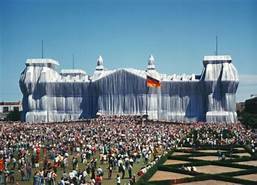

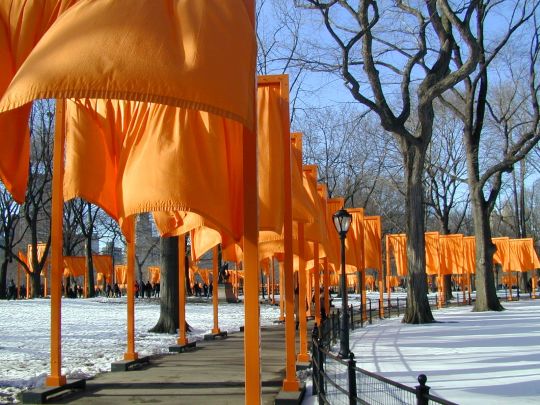
0 notes
Text
John Chamberlain
John Chamberlain was an American sculptor born in 1927 in Rochester, Indiana, and raised primarily by his grandmother following his parents’ divorce. Chamberlain served in the U.S Navy from 1943 to 1946 before working as a hairdresser and make-up artist, it was at this point he began to sketch and teach himself to draw. He then went on to attend the Art Institute of Chicago (1951-52) and the Black Mountain College (1955-56), attending at the same time as the Black Mountain Poets; Robert Creeley, Charles Olson and Robert Duncan. Chamberlain’s sculptures showed in New York along with the Abstract Expressionists, bringing that style of painting into the 3D.
Chamberlain was primarily known for his brilliantly coloured sculptures made from discarded car parts that he contorted and welded together to create enormous, dynamic shapes. Chamberlain was heavily influenced by fellow sculpturer David Smith, who’s creations were made from machine parts and old tools on iron rod frames. Chamberlain created his first sculpture Shortstop in 1957 by running a truck back and forth over car bumpers to bend them before fitting them together like a jigsaw puzzle. There is something defiant and obnoxious about this process, compounded by the scale and vibrant colours of his sculptures, that has the energy of a playful yet attention seeking child which I find endearing. Chamberlain went on to experiment with materials such as plexiglass, paper, polyurethane, industrial rubber and aluminium foil before returning to using car parts in 1974.
In finding your place in sculpture, you need to find the material that offers you just the right resistance. As it turns out, car metal offers me the correct resistance so that I can make a form—not overform it or underform it.
—John Chamberlain
Chamberlain explored the chemistry of colour, equilibrium and weight whilst tapping into the dynamism of Abstract Expressionism and remaining consistent to his approach of finding the right ‘fit’ by completing the puzzle. It seems to me that there is a sense of catharsis in the process of working with such hardy materials and a fanciful belief from Chamberlain that the new shape is there to be found.
I am drawn to Chamberlains later work he produced throughout, the 2000’s. He seems to have a developed a lightness and sense of movement in his work which was less prevalent in his earlier sculptures. I’m particularly drawn to Littlest Blue Moon and Memo to Mozart, there is a freedom to the sculptures and appear as they are almost blowing in the wind, which I find fascinating considering the density of the material used. There is a playful quality, compounded by the vivid colours, reminding me of party steamers and a sense of celebration.

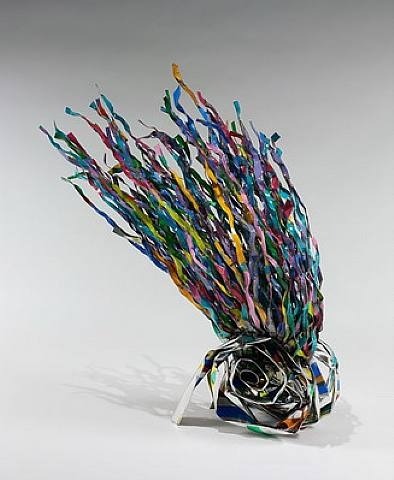
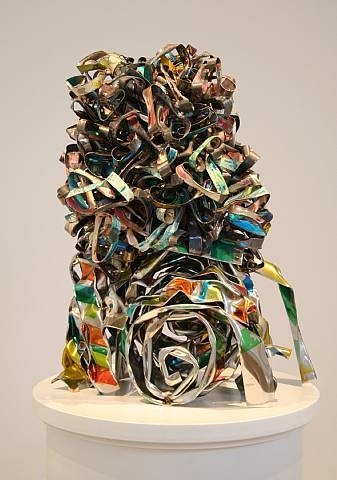


0 notes
Text
Hoch vs Britton (compare & contrast)
Hannah Hoch v Val Britton
Hoch and Britton are both mixed media artists, primarily using collage as their main medium. Although working in a similar medium both artists are extremely diverse in their application.
Hoch lived through the turn of the 19th century, living through two World Wars, under the Nazi Regime living in Berlin. This heavily influenced Hoch’s work where she primarily addresses political and social issues of her time, including androgyny and the ‘new woman’. Hoch pioneered photomontage and created pieces through dismemberment of popular media (newspapers/magazines) to further allude to viewing current issues through a different lens. Although Britton doesn’t address such issues she does explore using mix media and abstraction as a language similarly to Hoch. Hoch’s use of mix media explores a sense of movement to create an emotional and visceral impact in the form of maps which could be comparable to Hoch’s thought-provoking ‘view through a different lens’. In essence, both use mix media to further tell their stories through the use of the medium rather than solely relying on the direct image. Britton’s work is influenced by the passing of her father and both artists use their art as an emotional outlet to their personal circumstances. Britton’s work is clearly abstract, showing an amalgamation of shapes whereas Hoch use’s cut outs of realistic images to create something more abstract.
0 notes
Photo


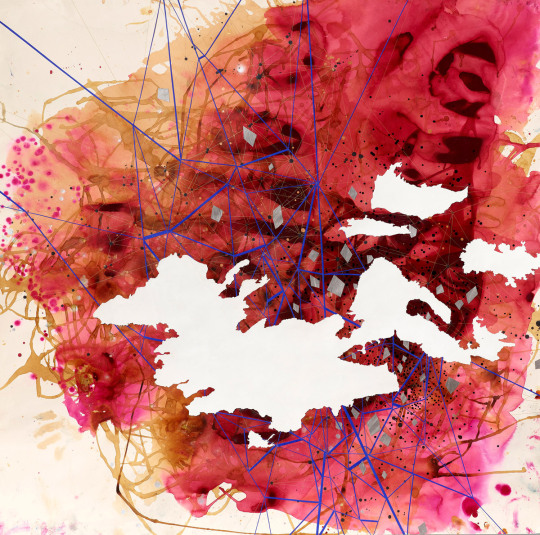

Val Britton
Val Britton is an American artist born in 1977 in Livingston, New Jersey. Britton lived in the San Francisco Bay Area for 14 years before moving to Portland, Oregon where she now resides. Britton studied Printmaking at Rhode Island School of Design inf 1999 and completed a masters at California College of Arts in 2006.
Britton was part of the Artist in Residence Program at Recology, San Francisco in 2010 where she created and exhibited ‘Index to Selected Stars’. Britton also presented at San Francisco gallery where her solo show ‘Passage’ was exhibited in 2014. Britton’s work is now part of numerous collections throughout the United States.
Britton is well known for producing immersive collages on paper along with installations which explore psychological and physical spaces. Britton’s mixed media work reference’s the language of maps and explores the psychological and emotional impact of journeys rather than just the physical routes. Britton’s methods navigate the blurry terrain of memory and imagination through creating fragmented and explosive landscapes. Britton’s father was a long-haul truck driver who passed away when she was a teenager, and uses this experience of influence the language of her work. Britton initially started tracing out the routes her father used to travel and has overtime developed the images into more fragmented pieces of loss and longing. Britton also explores abstraction as a language to a create an instinctive sense of movement through space to create an emotional impact. Britton is interested in exploring tension between order and chaos, the absolute and the imaginary and the known and the unknown.
0 notes
Photo




HANNAH HOCH
Hannah Hoch was born in Gotha, Germany in 1889. Hoch did attend school, however, in keeping with the times domesticity for a woman was considered a priority and subsequently she was taken out of school to look after her younger sibling, Marianne. In 1912 Hoch attended the College of Applied Arts in Berlin and studied glass design and graphic arts. At the start of World War I, in 1914, Hoch left school and returned to Gotha to work as part of the Red Cross but resorted back to Berlin in 1915 to attend the National Institute of the Museum of Arts and Crafts where she enrolled in the graphics class of Emil Orlik.
During 1915 Hoch also began a relationship with Raoul Hausmann, an established member of the Berlin Dada movement, thus beginning Hoch’s involvement with the Berlin Dadaists. Hoch was the only female amongst the Berlin Dadaists and was known for her masculine presence and bisexuality. Hoch addressed premise relating to the ‘New Woman’ focusing on the woman’s rights to vote, enjoy sexual encounters and have financial freedom. All of which were extremely forward thinking for her time. The Dada movement was heavily influenced by the sentiments that arose following World War primarily rejecting monarchy, militarism and conservatism and subsequently pushed the boundaries and restrictions of art to a more fantastical placed.
During 1916 to 1925 Hoch worked for the publisher Ullstein Verlag designing dresses and working with embroidery and lace which influenced her collage work where she incorporated sewing patterns and needlework.
Hoch spent the years of the war in Berlin and was the last member of the Berlin Dada group to stay in Germany during this period. Subsequently Hoch’s art was subject to Nazi censorship and deemed ‘degenerate art’ making it difficult to show her work during this time.
Hoch, along with Hausmann pioneered photomontage which Hoch continued to produce and exhibit internationally until her death in 1978. Hoch is best know for her photomontages, collages rearranging and dismembering images from populate culture. Hoch collated images and text from newspapers and magazines and reconfigured them in compositions addressing important social issues of her time. The mutilation and reconfiguration of the images implies the notion that current issues can be viewed through different lenses.
Hoch’s work addressed inherent sexism along with feminism, this along with her being a woman resulted in her never being fully accepted by the male Dadaists. Hoch’s work displayed primarily androgynous figures which was despised by the Nazi regime of the time due to their idealist strife for the Aryan man and woman.
Cut with the Kitchen Knife Dada through the Last Weimar Beer-Belly Cultural Epoch in Germany (1919)
This piece is Hoch’s most renowned work and shows a combination of images of the time, namely; sports stars, Dada artists, political leaders and mechanized images of Berlin. In the middle of the photomontage is a well known photograph of the first International Dada Fair (1920). This work of art is a direct condemnation of the failed attempt at democracy enforced by the Weimar Republic. It combines the central themes of Hoch’s work, the political state, androgyny and the ‘New Woman’.
0 notes
